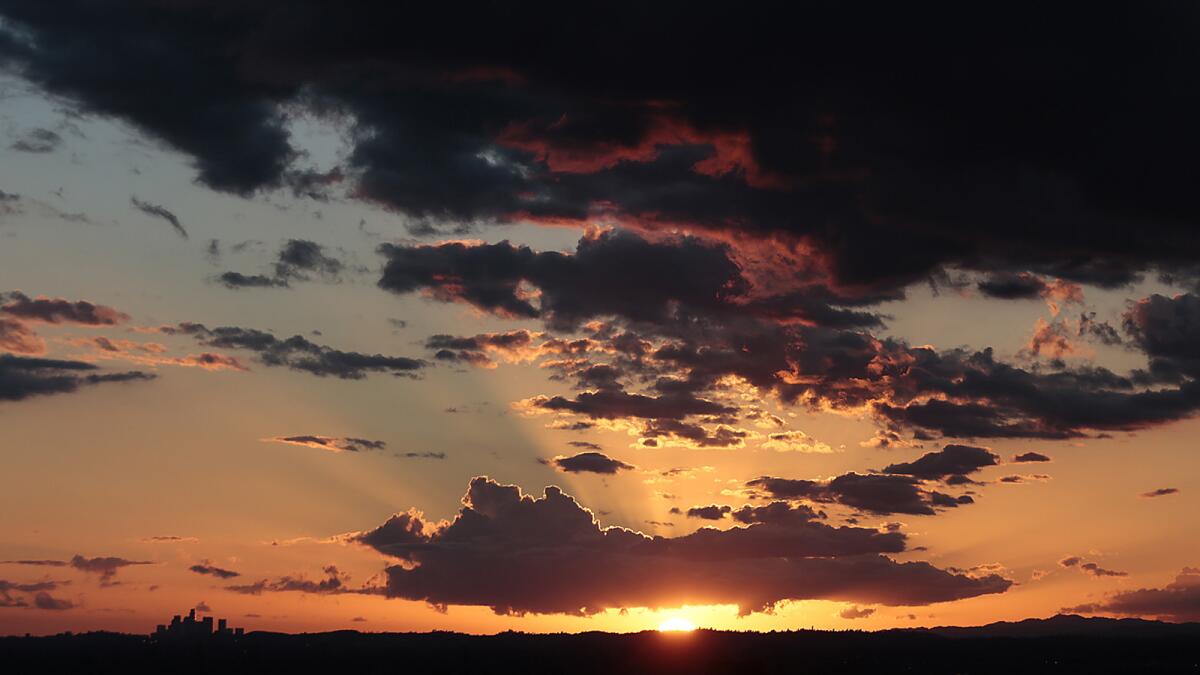It may seem like a healthy dose of rainfall for L.A., but it’s not

- Share via
When it’s as dry as it has been for three years, a couple of weeks of sporadic rain or a big storm or two in Los Angeles can make it seem as though Southern California is getting a healthy dose of rainfall.
But in fact, the city’s rain totals since Oct. 1 — the beginning of a rain year that ends Sept. 30 — show that L.A. is still on pace for a below-average year.
About 3.88 inches of rain fell on downtown L.A. in December, the most in that month in four years. And the region has been doused by more rainfall just in the last few days. But between that December and this February there was January — the month that is the traditional portal to Southern California’s three wettest months.
And that month was very dry, with just over an inch of rain. The average rainfall in January for downtown L.A. is over 3 inches.
When the Southland has been in an awful dry streak for several years, a middling rain year can come across as more substantial than it actually is.
In San Diego, Ventura, Los Angeles and Riverside counties, residents are seeing more rain than they did last year and, in most cases, more than they have since 2010, according to data from the National Weather Service.
For instance, downtown has received 6.42 inches of rain from Oct. 1 to Feb. 22; last year’s total during that same span was 1.11 inches. The historical average during that time is 10.16 inches.
Lindbergh Field in San Diego has received 5.43 inches, compared with 2.55 last year; the average over the last 30 years has been about 6.87 inches. Ontario Airport had only 1.14 inches of rain at this time last year. This year, it has received 7.35 inches, the weather service reported.
“It’s a lot compared to the last three years, but the last three years were the driest in the history of California,” said Bill Patzert, a climatologist with the Jet Propulsion Laboratory. “If you think we’ve turned around on the drought, stop smoking whatever you’re smoking.”
So far this month, downtown L.A. has received 0.7 inches of rain, nearly triple what the area received in 2014. A storm that crawled in off the coast over the weekend dropped up to 2 inches on some parts of the San Gabriel Mountains and drenched parts of Ventura County with a quarter-inch in only 10 minutes.
But like most of the rain that fell over California this year, its sense of location and timing wasn’t terribly well-honed.
“This year, we’re still not in good shape,” said Jayme Laber, a hydrologist with the National Weather Service.
For the most part, rain in Southern California has come down in heavy, isolated showers that saturate the ground at lower elevations and then is lost, sometimes flowing to the ocean. What the region needs is prolonged, moderate rain that can replenish groundwater and local basins.
The story in Northern California hasn’t been much different, Patzert said. A storm that passed through the upper half of the state in early February was too warm to add precious snow to the Sierra Nevada — one of California’s main resources during the long dry spells.
“You think you see the light at the end of the tunnel, but that’s called wishful thinking,” Patzert said. “All of a sudden, the tunnel gets longer.”
The storms that arrived this weekend were expected to flow away from Southern California by Monday night, forecasters say. Another storm is headed for the region by next weekend.
More to Read
Sign up for Essential California
The most important California stories and recommendations in your inbox every morning.
You may occasionally receive promotional content from the Los Angeles Times.














![Vista, California-Apri 2, 2025-Hours after undergoing dental surgery a 9-year-old girl was found unresponsive in her home, officials are investigating what caused her death. On March 18, Silvanna Moreno was placed under anesthesia for a dental surgery at Dreamtime Dentistry, a dental facility that "strive[s] to be the premier office for sedation dentistry in Vitsa, CA. (Google Maps)](https://ca-times.brightspotcdn.com/dims4/default/07a58b2/2147483647/strip/true/crop/2016x1344+29+0/resize/840x560!/quality/75/?url=https%3A%2F%2Fcalifornia-times-brightspot.s3.amazonaws.com%2F78%2Ffd%2F9bbf9b62489fa209f9c67df2e472%2Fla-me-dreamtime-dentist-01.jpg)